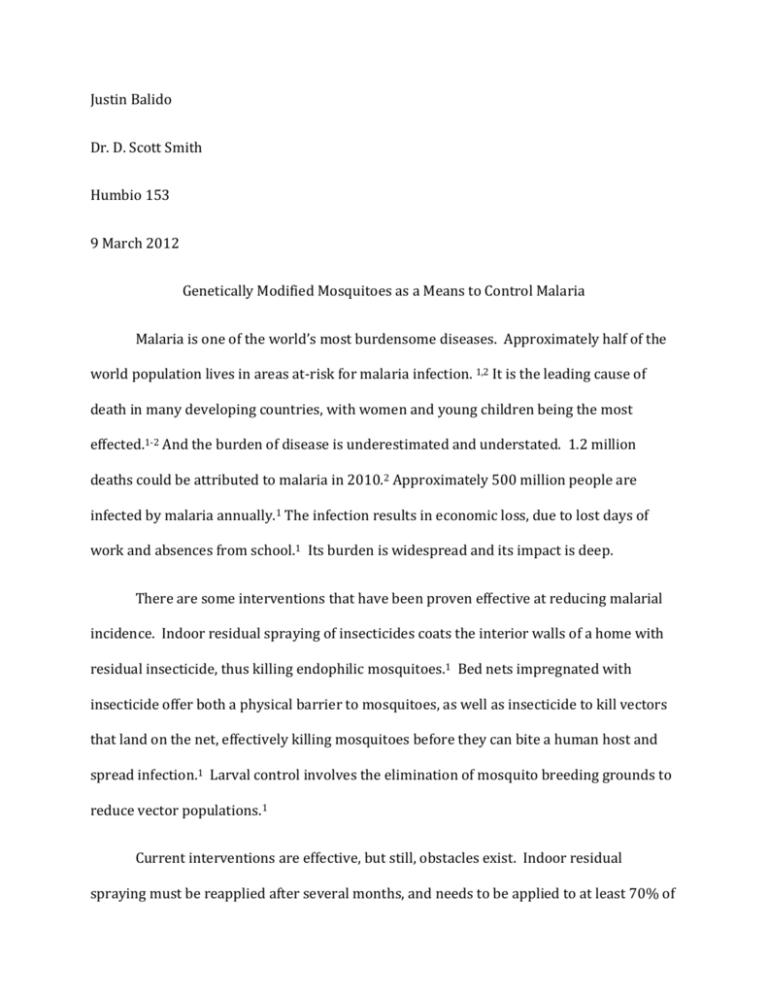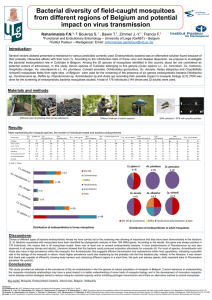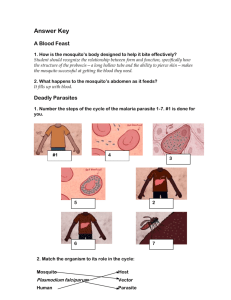doc
advertisement

Justin Balido Dr. D. Scott Smith Humbio 153 9 March 2012 Genetically Modified Mosquitoes as a Means to Control Malaria Malaria is one of the world’s most burdensome diseases. Approximately half of the world population lives in areas at-risk for malaria infection. 1,2 It is the leading cause of death in many developing countries, with women and young children being the most effected.1-2 And the burden of disease is underestimated and understated. 1.2 million deaths could be attributed to malaria in 2010.2 Approximately 500 million people are infected by malaria annually.1 The infection results in economic loss, due to lost days of work and absences from school.1 Its burden is widespread and its impact is deep. There are some interventions that have been proven effective at reducing malarial incidence. Indoor residual spraying of insecticides coats the interior walls of a home with residual insecticide, thus killing endophilic mosquitoes.1 Bed nets impregnated with insecticide offer both a physical barrier to mosquitoes, as well as insecticide to kill vectors that land on the net, effectively killing mosquitoes before they can bite a human host and spread infection.1 Larval control involves the elimination of mosquito breeding grounds to reduce vector populations.1 Current interventions are effective, but still, obstacles exist. Indoor residual spraying must be reapplied after several months, and needs to be applied to at least 70% of an affected area to be effective.1 And mosquitoes have developed resistance to the insecticide used in both residual spraying and impregnated bed nets.1 Larval control requires constant surveillance to find pools of stagnant water in which mosquitoes can breed.1 Alternative interventions should be explored, to create a sustainable solution to reducing malaria prevalence and incidence globally. One potential intervention is biological control of the vector, by releasing engineered mosquitoes.3,4 First, biologists breed mosquitoes, to express certain traits, which will be discussed later. Then, these mosquitoes are released into the wild, which the target mosquito population inhabits. With some luck, the scientist-bred mosquitoes are fit and competitive enough to mate with wild mosquitoes. Thus, the trait is passed on to the next generation.3,4 There are two goals to this type of intervention.4 The first is population reduction. By releasing sterile insects into the wild population, females that mate with the sterile males will produce eggs that will ultimately not produce mosquitoes.5 Alternatively, engineered males will mate with wild females, which will result in larvae with lethal genes, thus killing the larvae before they can become a malaria-spreading mosquito.5 By reducing the mosquito population, you reduce the vector, and thus reduce the incidence of malaria. The second goal is population replacement.3,4 Instead of wiping out populations of mosquitoes, the goal is to engineer mosquitoes that are resistant to malaria. Thus, instead of getting rid of the vector, we simply reduce the infectivity of the vector, and, again, reduce malaria incidence. Population reduction is a well-documented field, and the technique is known as the Sterile Insect Technique (SIT). In the past, it has been done by irradiation and chemosterilization, and cytoplasmic incompatibility. Cytoplasmic incompatibility involves the infection of mosquitoes with the symbiont Wolbachia, which will kill wild mosquito eggs that are not naturally infected with the bacteria.5 However, in moving forward, transgenic sterilization has gained more interest, due to its potential efficacy, as well as its reversibility should it result in undesirable effects.4,5 Sterile Insect Technique has been studied since the 1960s as a means to control pests, including vectors of disease, such as mosquitoes. Mosquito releases were often research-based in nature, and not intended to suppress or control populations. Releases against culex mosquitoes were the first to experience success, in Myanmar with cytoplasmic incompatibility, and in France with genetic modification.5 The first trial of sterile insect technique application in a malaria vector that experienced success was the elimination of the species anopheles albimanus in an isolated area of El Salvador in 1972. In this trial, vector sterilization was done chemically. Over 22 weeks, 4.4 million male mosquitoes were released into the area surrounding Lake Apastepeque. By the end of the trial, the mosquito population was eliminated, and researchers gained an increased understanding of sterile insect technique.5 However, when an attempted a larger-scale project went underway in El Salvador, there was inability to match results. In order to achieve population suppression, the researchers had to reduce the target area by 20 square kilometers. Likewise, in India, the World Health Organization (WHO) and the Indian Council of Medical Research (ICMR) worked together to reduce mosquito populations, including the indigenous vector for malaria. Despite the large amounts of mosquitoes released, there was minimal effect observed on the overall populations of mosquitoes. This was attributed to mosquito migration from outside the target population. This both increased the population, and introduced fertile males to mate with the females, reducing or eliminating any effect the sterile insects may have had.5 The other option to the biological control of the malaria vector is population replacement.3,4 In pursuing this option, populations of anopheline mosquitoes are replaced by mosquito populations that express resistance to malaria. Research is currently underway to determine the best genetic approach that would allow this to occur.3,4 While the ways to confer resistance to malaria in mosquitoes are many, there is one model that has been proven successful in rodent malaria. Researchers at Johns Hopkins have identified the receptor sites in the midgut of the mosquito that sporozoites require to pass through the wall of the midgut, as well as the receptors on the outside of the salivary glands that are required for the parasite to enter. Without these sites, sporozoites cannot reach the salivary glands, and thus cannot infect another rodent. A protein has been found that occupies the same receptor site as the sporozoite. By introducing large amounts of the protein into the mosquito, the receptor sites are inaccessible to the parasite, and therefore the sporozoite will stay in the midgut, unable to pass on to a human host.3 Another successful malaria resistance study has been conducted in chickens. In this study, an antibody was engineered from a surface protein of the plasmodium parasite. A virus was used to insert the gene into the mosquito DNA, and have the mosquito express the gene. The antibodies were able to reduce the number of sporozoites in the salivary glands of infected mosquitoes by 99.9%.6 To induce resistance in humans, a number of factors must be identified in order to make such an intervention feasible, let alone successful. For a protein to be expressed in the mosquito, an endogenous promoter must first be found – a gene already in the mosquito that can both activate and control the production of the exogenous gene product. By finding an endogenous promoter, there would have to be less genetic engineering for an outside gene to work. An engineered gene must be attached and placed in the DNA so that the promoter will act upon it.3,4,7 One study accomplished this using bloodmeal-triggered gene activation. This study has the distinct advantage of using anti-malarial genes already present in the anopheles mosquitoes. There has been extensive research done examining any immunity that anopheles mosquitoes may already contain in their genome. Drawing upon this research, this study genetically engineered mosquitoes to over-express these plasmodium-resistant genes, and attached these genes to promoters activated upon bloodmeals. This has a number of advantages. One of them is that fitness is less likely to reduced, because the genes are already present in the genome. Another is that by attaching the malaria resistance genes to promoters induced by bloodmeal, the immune response acts upon the plasmodium soon after it enters the mosquito, before it has had a chance to penetrate the wall of the midgut.7 This study highlights the advantages of endogenous promoters – because both the genes and the promoters were inherent in the mosquito’s genome, it offers greater potential for success. Another aspect of the use of genetically modified mosquitoes as an intervention is that needs further research is drive systems. Drive systems are constructs that help a introduced gene spread quickly and effectively throughout a population.3,4 In order for a population replacement intervention to be successful, the exogenous gene must be introduced into the entire population. Thus, a mechanism is needed to ensure its spread. Transposable elements were one of the first drive systems to become popular in research. The nature of transposable elements is such that they can replicate themselves in the host’s genome. By doing so, the probability of the exogenous gene being passed on to offspring is raised. There have been a number of successful projects in which Aedes aegypti mosquitoes have been transformed. However, there have been a number of hurdles in using transposable elements in mosquito engineering. One of these barriers is the fact that the transposable elements tend to suppress their own activity in order to preserve the host genome. So, even if a transposable element tied to a refractory gene were to spread throughout the population, if it does not allow the exogenous gene to produce its antimalarial protein, there is no point to population replacement. Furthermore, transposable elements mutate over time, threatening the sustainability of an intervention using genetic modifications based on transposable elements. Another barrier of transposable elements is the reduction of activity with increasing size. Genes inducing malarial resistance are large in size, and thus adding them would greatly reduce the activity of the transposable element, and thus the anti-malarial effect would be reduced.3,4 Another drive system currently being researched is Medea. Medea is a gene found naturally in the flour beetle. This gene expresses both a toxin and an antidote to the toxin. If an offspring is born heterozygous for the Medea gene, it will experience only the toxin and not the antidote, and die. Therefore, if you attach an anti-malarial gene to Medea, any offspring not carrying the malaria refractory gene will also die. Although it cannot be ensured that every mosquito will inherit the refractory gene, Medea helps skew the offspring ratio toward malaria resistance.3 Another approach to using genetic engineering to reduce the incidence of malaria is the infection of mosquitoes with transgenic fungi. In one study, researchers modified the fungus Metarhizium anisopliae to induce plasmodium resistance in mosquitoes, which has the advantage of infected the mosquito directly through its cuticle to the hemolymph. The fungus was given a variety of genes to achieve this goal. One gene functioned similarly to the rodent studies, and blocked receptors that plasmodium sporozoites need to bind to in order to reach the salivary glands. Another gene introduced promoted production of an antibody, which causes plasmodium to agglutinate within the mosquito, rendering it unable to infect a human host. Infection of mosquitoes with fungi possessing these properties would make the infected mosquitoes resistant to malaria, and thus reduce incidence in endemic areas.8 One advantage of transgenic fungus is that there is reduced – but not eliminated concern for developed resistance. Fungal infection of mosquitoes only kills mosquitoes that are older. Thus, mosquitoes that are resistant to fungal infection are not selected for, since the mosquitoes dying from the infection are the same mosquitoes that were going to die anyway. Additionally, these fungal spores can survive on treated surfaces for months – so, where insecticide resistance has developed, the same interventions can be used, except with fungus treatment instead of insecticide.8 The concern about natural selection can also be applied to transgenic mosquitoes. In order for a transgenic mosquito intervention to be successful, the genes must be selected for, or at the very least, not selected against. Transgenic mosquitoes must be both fit enough to survive, and competitive enough to mate.3-5 One study points out that mosquitoes have not developed complete resistance to malaria parasites, and hypothesizes that defense mechanisms protecting the mosquito against malaria are costly, and confer lesser fitness. Using statistical modeling, the study examined a rodent plasmodium resistant population, a plasmodium susceptible population, and a wild control population. In nearly all fronts, both the control and plasmodium susceptible populations outperformed the plasmodium resistant ones. The mean population growth rate was lower in the plasmodium resistant population than in both the plasmodium susceptible and control. The plasmodium resistant only outperformed the plasmodium susceptible in pupation success, and only outperformed the control in egg production. However, the most life cycle stages that have the greatest affect on lifetime fitness are the larval stage and the gravid female stage - stages in which the plasmodium resistant mosquito saw less success than the control and susceptible groups.9 Despite these obstacles, there are advantages to pursuing interventions involving genetically modified mosquitoes. One of the greatest advantages to using biological vector control is the reduced dependence on human compliance. As mentioned earlier, indoor residual spraying requires at least 70% population compliance to be effective in reducing the incidence of malaria in the target area. Likewise, despite the availability of insecticide treated bed nets, people do not always use them.1 Even the transgenic fungus intervention discussed earlier in this paper has some reliance on human compliance.8 In interventions using transgenic mosquitoes, the residents of the target area do not need to do anything. The mere release of these mosquitoes in the environment is the extent of the intervention that occurs in the target area. Another advantage, and perhaps the most promising one, is sustainability. If an anti-malarial gene that is introduced into a population persists throughout generations, then no further intervention may be needed. This, indeed, is a lofty goal, but this is a distinct advantage to this sort of intervention. While other prior interventions have focused on affecting the population of the vector, no other intervention has focused on changing the nature of the vector. If the nature of the vector is altered, then the nature of the disease changes. While this goal is not feasible with current technologies, it is a potentially sustainable solution to this humanitarian crisis.3-4 However, many disadvantages exist to pursuing such a treatment. One of the primary concerns is ethics. In order to pursue this research, researchers must do field tests to determine effectiveness. However, in doing field research, informed consent is required of the participating communities. It is questionable whether we have the resources to educate entire communities about the intervention. Furthermore, if we were able to reach to every member in the community, we would have to ensure that they fully understand the nature of the technology, and more importantly, the risks involved with intervention. Also, given the migratory nature of mosquitoes, there is the issue of the genetically modified mosquitoes going outside the target area, and thus subjecting the intervention on a community that has not given consent. The problem that arises, then, is whether or not it is appropriate to proceed with this intervention without properly obtained informed consent of the population.10 Furthermore, in a previous Indian trial, media sensationalism resulted in backlash to the research. The researchers were accused of carrying out biological warfare, which, while untrue, proved problematic in obtaining consent of the community.5 Another ethical concern is the conflict genetic modification has with religious issues. Some religions do not allow harm to other living beings – including insects. Thus, with a intervention like sterile insect technique, we must consider the desires of the population. For instance, Jainism is one such religion that does not allow for harm to other living creatures. It is a religion based in India, where malaria is endemic.10 This in itself is a problem to treating the target area, but it also presents a problem to neighboring areas. Mosquito migration was problematic in the El Salvador trials, and poses a considerable barrier to intervention success.5 Biosafety is of course another concern. The Cartagena Protocol on Biosafety to the Convention on Biological diversity is an international agreement regarding the usage of transgenic organisms. One of the highlights of this protocol is the Precautionary Principle – it states that an action that may potentially cause risk to the environment must be weighted against the ability for scientists to ameliorate potential damage. Furthermore, the protocol states that we should pursue the least harmful alternative – that is, use genetically modified mosquitoes only as a last resort.11 Lastly, the issue of sustainability is also a question. For widespread application, we must find a gene that has a high probability of effectiveness. However, a chance still remains that the gene is not properly driven into the wild population. Thus, a population may be replaced briefly by a plasmodium resistant population, but the may not be stable within the wild population.9 Natural selection and fitness could cause the gene to disappear.8 Furthermore, population replacement cannot be managed with a single release of mosquitoes. Millions of mosquitoes could be necessary to obtain an observable effect in the population, and it could require regular releases of mosquitoes to ensure the refractory gene remains in the population.5 Given this information, there is no clear direction moving forward. Each technology has its own merits, and has its own drawbacks. While some believe that genetically modified mosquitoes should first be used to eliminate mosquito populations, there are others who believe that the ecological ramifications do not outweigh the benefits.11,12 Furthermore, while some believe that population replacement using genetically modified mosquitoes should be a last resort, while others place it higher on their list of interventions.11,12 What is clear is that further research should be done to properly assess the risks, benefits, and effectiveness of such a technique. There is no clear direction to move from this point – simply, forward. Works Cited 1. Smith, D. Scott Talk presented at: Global Health Education Consortium; October 2009; Stanford, CA. Accessed March 8, 2012. 2. Murray C, Rosenfeld L, Lim S, et al. Global malaria mortality between 1980 and 2010: a systematic analysis. The Lancet. 2012;379(9814): 413-431. http://www.thelancet.com/journals/lancet/article/PIIS0140-6736(12)600348/fulltext. Accessed March 8, 2012. 3. Marshall JM, Taylor CE (2009) Malaria Control with Transgenic Mosquitoes. PLoS. 2009; 6(2): e1000020. Accessed March 8, 2012. 4. Christophides, G. Transgenic mosquitoes and malaria transmission. Cellular Microbiology. 2005;7(3):325-333. Accessed March 8, 2012. 5. Benedict M, Robinson A. The first releases of transgenic mosquitoes: an argument for the sterile insect technique. TRENDS in Parasitology. 2003;19(8): 349-355. Accessed March 8, 2012. 6. James AA. Engineeering mosquito resistance to malaria parasites: the avian malaria model. Insect Biochemistry and Molecular Biology. 2002; 32(10): 1317-1323. Accessed March 8, 2012. 7. Dong Y, Das S, Cirimotich C, Souza-Neto JA, McLean KJ, et al. Engineered Anopheles Immunity to Plasmodium Infection. PLoS Pathog. 2011;7(12): e1002458. Accessed March 8, 2012. 8. Fang W, et al. Development of Transgenic Fungi That Kill Human Malaria Parasites in Mosquitoes. Science. 2011;331(1074):1074-1077. Accessed March 8, 2012. 9. Voordouw M, Anholt B, Taylor P, Hurd H. Rodent malaria-resistant strains of the mosquito, Anopheles gambiae, have slower population growth than susceptible strains. BMC Evolutionary Biology. 2009;9(76). Accessed March 8, 2012. 10. Lavery J, Harrington L, Scott T. Perspective: Ethical, Social, and Cultural Considerations for Site Selection for Research with Genetically Modified Mosquitoes. Am. J. Trop. Med. Hyg. 2008;79(3): 312-318. Accessed March 8, 2012. 11. Ostera G, Gostin L. Biosafety Concerns Involving Genetically Modified Mosquitoes to Combat Malaria and Dengue in Developing Countries. JAMA. 2011;305(9): 930-931. Accessed March 8, 2012. 12. Benedict, M. Safety of Genetically Modified Mosquitoes. JAMA. 2011;305(20): 20692070. Accessed March 8, 2012.




